Note
Go to the end to download the full example code
EfficientGlobalOptimization examples¶
The EGO algorithm (Jones, 1998) is an adaptative optimization method based on kriging.
An initial design of experiment is used to build a first metamodel. At each iteration a new point that maximizes a criterion is chosen as optimizer candidate.
The criterion uses a tradeoff between the metamodel value and the conditional variance.
Then the new point is evaluated using the original model and the metamodel is relearnt on the extended design of experiment.
from openturns.usecases import branin_function
from openturns.usecases import ackley_function
import openturns as ot
import openturns.viewer as viewer
from matplotlib import pylab as plt
ot.RandomGenerator.SetSeed(0)
ot.ResourceMap.SetAsString("KrigingAlgorithm-LinearAlgebra", "LAPACK")
ot.Log.Show(ot.Log.NONE)
Ackley test-case¶
We first apply the EGO algorithm on the Ackley function.
Define the problem¶
The Ackley model is defined in the usecases module in a data class AckleyModel :
am = ackley_function.AckleyModel()
We get the Ackley function :
model = am.model
We specify the domain of the model :
dim = am.dim
lowerbound = [-4.0] * dim
upperbound = [4.0] * dim
We know that the global minimum is at the center of the domain. It is stored in the AckleyModel data class.
xexact = am.x0
The minimum value attained fexact is :
fexact = model(xexact)
fexact
graph = model.draw(lowerbound, upperbound, [100] * dim)
graph.setTitle("Ackley function")
view = viewer.View(graph)
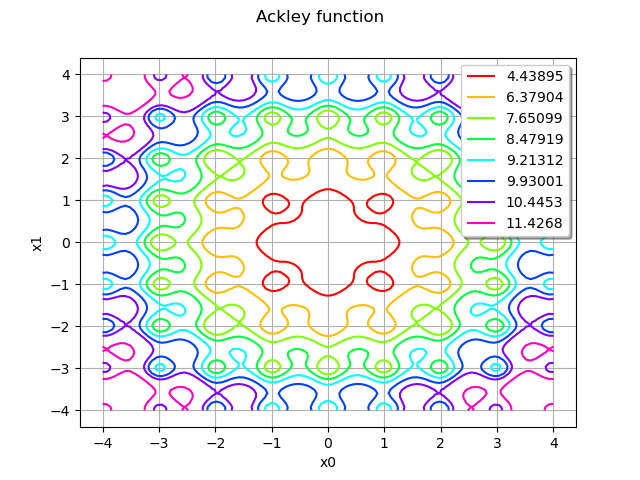
We see that the Ackley function has many local minimas. The global minimum, however, is unique and located at the center of the domain.
Create the initial kriging¶
Before using the EGO algorithm, we must create an initial kriging. In order to do this, we must create a design of experiment which fills the space. In this situation, the LHSExperiment is a good place to start (but other design of experiments may allow to better fill the space). We use a uniform distribution in order to create a LHS design with 50 points.
listUniformDistributions = [
ot.Uniform(lowerbound[i], upperbound[i]) for i in range(dim)
]
distribution = ot.ComposedDistribution(listUniformDistributions)
sampleSize = 50
experiment = ot.LHSExperiment(distribution, sampleSize)
inputSample = experiment.generate()
outputSample = model(inputSample)
graph = ot.Graph(
"Initial LHS design of experiment - n=%d" % (sampleSize), "$x_0$", "$x_1$", True
)
cloud = ot.Cloud(inputSample)
graph.add(cloud)
view = viewer.View(graph)
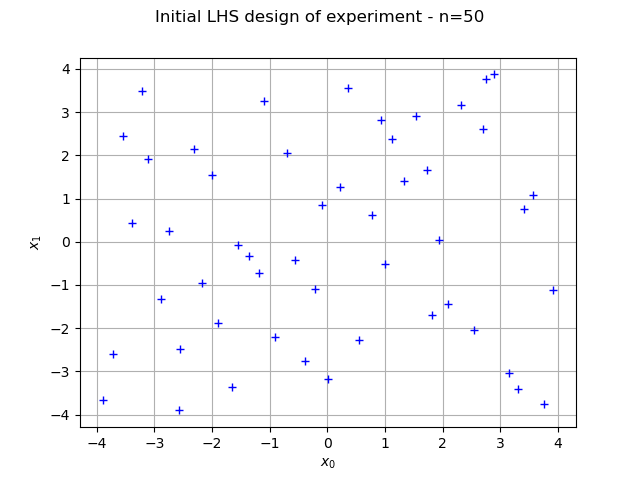
We now create the kriging metamodel. We selected the SquaredExponential covariance model with a constant basis (the MaternModel may perform better in this case). We use default settings (1.0) for the scale parameters of the covariance model, but configure the amplitude to 0.1, which better corresponds to the properties of the Ackley function.
covarianceModel = ot.SquaredExponential([1.0] * dim, [0.5])
basis = ot.ConstantBasisFactory(dim).build()
kriging = ot.KrigingAlgorithm(inputSample, outputSample, covarianceModel, basis)
kriging.run()
Create the optimization problem¶
We finally create the OptimizationProblem and solve it with EfficientGlobalOptimization.
problem = ot.OptimizationProblem()
problem.setObjective(model)
bounds = ot.Interval(lowerbound, upperbound)
problem.setBounds(bounds)
In order to show the various options, we configure them all, even if most could be left to default settings in this case.
The most important method is setMaximumEvaluationNumber which limits the number of iterations that the algorithm can perform. In the Ackley example, we choose to perform 10 iterations of the algorithm.
algo = ot.EfficientGlobalOptimization(problem, kriging.getResult())
algo.setMaximumEvaluationNumber(10)
algo.run()
result = algo.getResult()
result.getIterationNumber()
10
result.getOptimalPoint()
result.getOptimalValue()
fexact
Compared to the minimum function value, we see that the EGO algorithm provides solution which is not very accurate. However, the optimal point is in the neighbourhood of the exact solution, and this is quite an impressive success given the limited amount of function evaluations: only 60 evaluations for the initial DOE and 10 iterations of the EGO algorithm, for a total equal to 70 function evaluations.
graph = result.drawOptimalValueHistory()
view = viewer.View(graph)
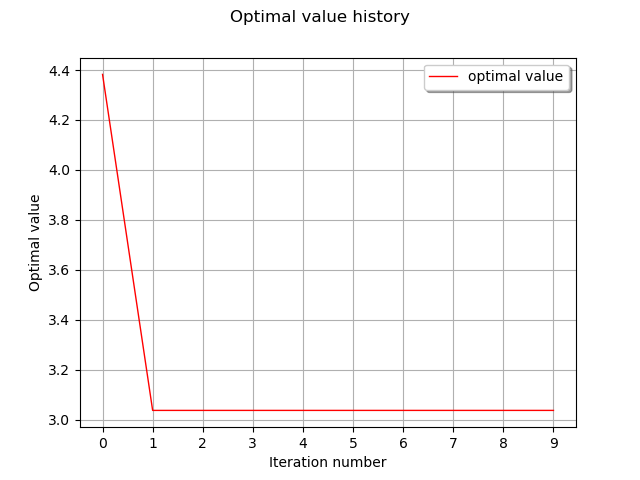
inputHistory = result.getInputSample()
graph = model.draw(lowerbound, upperbound, [100] * dim)
graph.setLegends([""])
graph.setTitle("Ackley function. Initial : black bullet. Solution : green diamond.")
cloud = ot.Cloud(inputSample)
cloud.setPointStyle("bullet")
cloud.setColor("black")
graph.add(cloud)
cloud = ot.Cloud(inputHistory)
cloud.setPointStyle("diamond")
cloud.setColor("forestgreen")
graph.add(cloud)
view = viewer.View(graph)
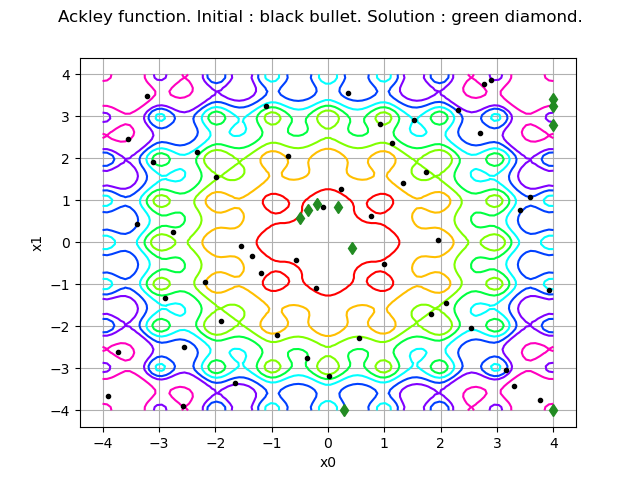
We see that the initial (black) points are dispersed in the whole domain, while the solution points are much closer to the solution.
However, the final solution produced by the EGO algorithm is not very accurate. This is why we finalize the process by adding a local optimization step.
algo2 = ot.NLopt(problem, "LD_LBFGS")
algo2.setStartingPoint(result.getOptimalPoint())
algo2.run()
result = algo2.getResult()
result.getOptimalPoint()
The corrected solution is now extremely accurate.
graph = result.drawOptimalValueHistory()
view = viewer.View(graph)
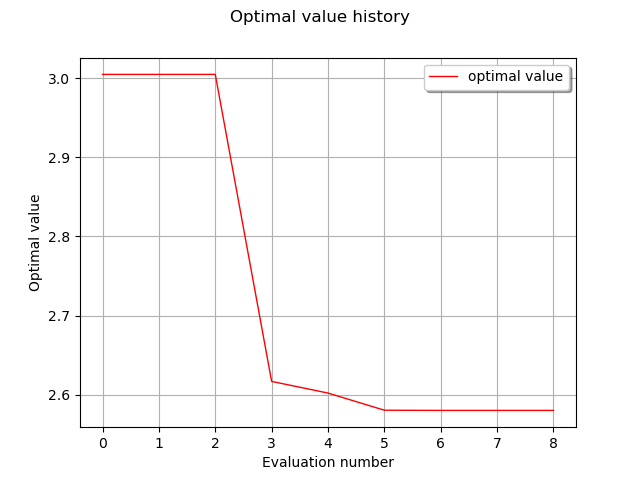
Branin test-case¶
We now take a look at the Branin-Hoo function.
Define the problem¶
The Branin model is defined in the usecases module in a data class BraninModel :
bm = branin_function.BraninModel()
We load the dimension,
dim = bm.dim
the domain boundaries,
lowerbound = bm.lowerbound
upperbound = bm.upperbound
and we load the model function and its noise :
objectiveFunction = bm.model
noise = bm.noiseModel
We build a sample out of the three minima :
xexact = ot.Sample([bm.xexact1, bm.xexact2, bm.xexact3])
The minimum value attained fexact is :
fexact = objectiveFunction(xexact)
fexact
graph = objectiveFunction.draw(lowerbound, upperbound, [100] * dim)
graph.setTitle("Branin function")
view = viewer.View(graph)
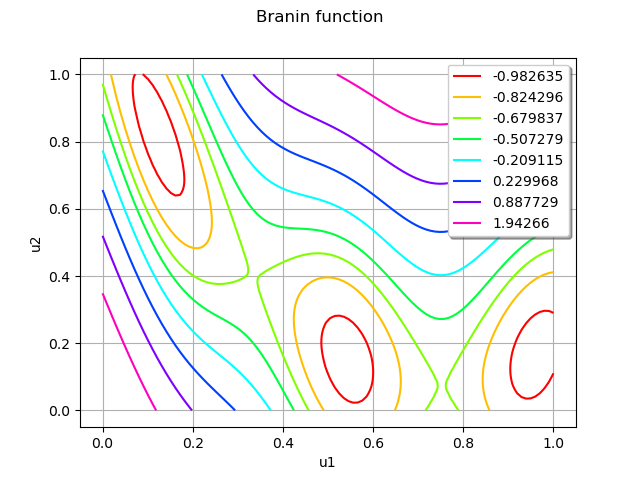
The Branin function has three local minimas.
Create the initial kriging¶
distribution = ot.ComposedDistribution([ot.Uniform(0.0, 1.0)] * dim)
sampleSize = 50
experiment = ot.LHSExperiment(distribution, sampleSize)
inputSample = experiment.generate()
outputSample = objectiveFunction(inputSample)
noiseSample = noise(inputSample)
graph = ot.Graph(
"Initial LHS design of experiment - n=%d" % (sampleSize), "$x_0$", "$x_1$", True
)
cloud = ot.Cloud(inputSample)
graph.add(cloud)
view = viewer.View(graph)

covarianceModel = ot.SquaredExponential([1.0] * dim, [1.0])
basis = ot.ConstantBasisFactory(dim).build()
kriging = ot.KrigingAlgorithm(inputSample, outputSample, covarianceModel, basis)
kriging.setNoise([x[0] for x in noiseSample])
kriging.run()
Create and solve the problem¶
We define the problem :
problem = ot.OptimizationProblem()
problem.setObjective(objectiveFunction)
bounds = ot.Interval(lowerbound, upperbound)
problem.setBounds(bounds)
We configure the algorithm, with the model noise:
algo = ot.EfficientGlobalOptimization(problem, kriging.getResult(), noise)
algo.setMaximumEvaluationNumber(20)
We run the algorithm and get the result:
algo.run()
result = algo.getResult()
result.getIterationNumber()
20
result.getOptimalPoint()
result.getOptimalValue()
fexact
inputHistory = result.getInputSample()
graph = objectiveFunction.draw(lowerbound, upperbound, [100] * dim)
graph.setLegends([""])
graph.setTitle("Branin function. Initial : black bullet. Solution : green diamond.")
cloud = ot.Cloud(inputSample)
cloud.setPointStyle("bullet")
cloud.setColor("black")
graph.add(cloud)
cloud = ot.Cloud(inputHistory)
cloud.setPointStyle("diamond")
cloud.setColor("forestgreen")
graph.add(cloud)
view = viewer.View(graph)
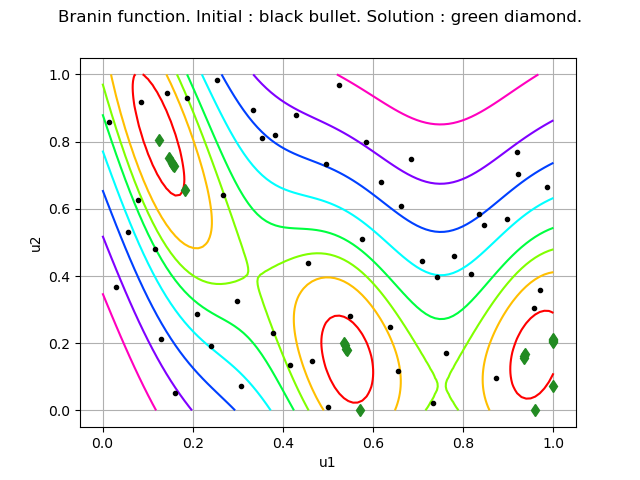
We see that the EGO algorithm found the second local minimum. Given the limited number of function evaluations, the other local minimas have not been explored.
graph = result.drawOptimalValueHistory()
view = viewer.View(graph, axes_kw={"xticks": range(0, result.getIterationNumber(), 5)})
plt.show()
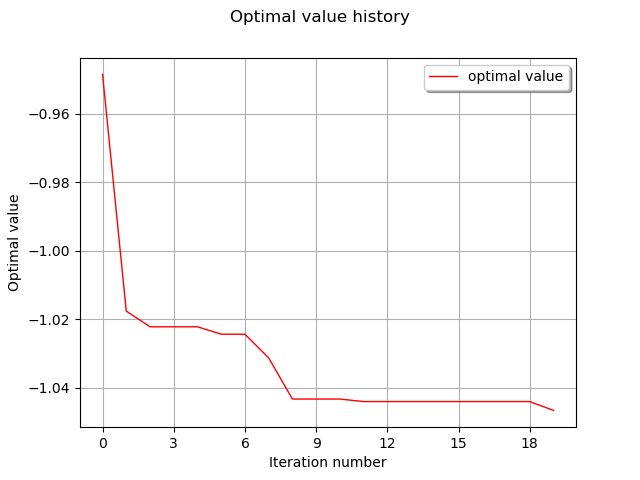
Total running time of the script: ( 0 minutes 4.390 seconds)
 OpenTURNS
OpenTURNS